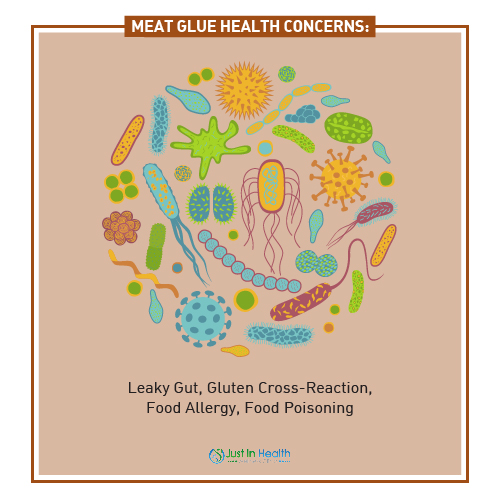

By Dr. Justin Marchegiani
Do you remember hearing about ‘pink slime’ in meat a few years back? It was all over the news, generating mass outrage–but then people seemed to forget and move on. Concerningly, meat glue is still being used in meat today, and you may even have it in your fridge right now.
It’s perhaps a little disturbing, but not surprising, to learn that a pack of ground beef can contain meat from hundreds of animals located around the globe, but did you know your steak may be made up of different animals and glued together to appear as one whole piece? Pieces of meat that are too small to sell are oftentimes glued together with an enzyme called microbial transglutaminase, commonly referred to as meat glue.
We know enzymes are good, so why is transglutaminase so scary? The meat glue enzyme (mTG) is produced from a strain of bacteria called Streptoverticillium1. In previous decades, it was taken from guinea pig livers, but today manufacturers go for the cheaper option and source this compound from cow or pig blood plasma.
It is then cultivated and dried into a powder which is sprinkled on meat, where it becomes the infamous ‘pink slime,’ and the meat is wrapped in plastic wrap and refridgerated. The reaction of mTG and meat protein linking up creates a seamless bond: even expert butchers can’t discern a ‘real’ from a ‘fake’ steak!

There’s a reason the title of this piece is “the *hidden* ingredient that’s making you sick,” food manufacturers are not required to disclose the use of meat glue. It’s a shady practice: the manufacturer glues together scraps of meat that would have otherwise been discarded, and sells it from a premium under the guise of it being a real steak. Besides being deceitful, meat glue comes with health risks that we want to be able to avoid.
Meats treated with meat glue mTG have a higher possibility of spreading food poisoning. Bacterial contamination of these glued steaks is hundreds of times higher than a pure piece of steak, which is exponentially more risky for those who like their steak rare. Additionally, since meat glued steaks contain meat from an unknown number of cows, when outbreaks occur, it’s near impossible to know which batches are contaminated.
Microbial transglutaminase has been shown to increase gut permeability, which can cause all sorts of leaky gut related issues, like fatigue, digestive issues, cognition problems, nutrient deficiencies, and more. Meat glue can also create symptoms in those with Celiac disease, as mTG acts as a binder, can increase the potency of gluten, and cause cross-reactivity.
Click here to work with a functional medicine doctor if you are suffering from leaky gut symptoms!
As a binder, meat glue also binds to proteins which creates antigenic peptides: these can trick your body into thinking the proteins are an allergen, which sends the body into an autoimmune response. Meat glue can drive inflammation, autoimmunity, food allergies, leaky gut–not to mention the higher risk of food poisoning. Everyone should be staying away from this substance–but if it’s not required to list on the food packaging, how do you avoid it?

So, how do you avoid this gross and potentially dangerous additive if manufacturers are allowed to process meat with mTG pink slime without disclosing it? Your best bet is to support local farmers who you trust. If you must shop at a grocery store, choose organic grass-fed and grass-finished meat fresh from the butcher’s counter.
Microbial transglutaminase is also used in processed foods like sausage, cheese, and yogurt, so your best bet is to eat fresh foods, and to choose high quality cheeses and yogurts–raw (unpasteurized) or goat’s milk are better dairy choices.
Luckily, if you are eating a diet high in healthy fats, organic veggies, and grass-fed proteins, you are probably already avoiding most sources of mTG. I recommend a paleo-keto type of diet as it is best for burning fat and increasing energy. If you think you may be suffering from health issues related to mTG, you may want to try an elimination diet to give your body a reset.
Click here to ask a functional medicine doctor about the elimination diet!
References:
http://www.ajiusafood.com/products/enzymes/activa.aspx
http://wwwnc.cdc.gov/eid/content/5/5/contents.htm
http://farmandranchfreedom.org/letter-dr-huber-roundup-animal-miscarriage-infertility/
Kieliszek, M. and Misiewicz, A. (2013). Microbial transglutaminase and its application in the
food industry. A review. Folia Microbiol. 59, 241-250.
Lerner, A., Matthias, T. (2015). Possible association between celiac disease and bacterial
transglutaminase in food processing: a hypothesis. Nutrition Reviews. 73(8), 544-552.
Skovbjerg, H., Koch, C., Anthosen, D., Sjostrom, H. (2004). Deamidation and cross-linking of
gliadin peptides by transglutaminases and the relation to celiac disease. Biochimica et Biophysica Acta. 1690(3), 220-230.